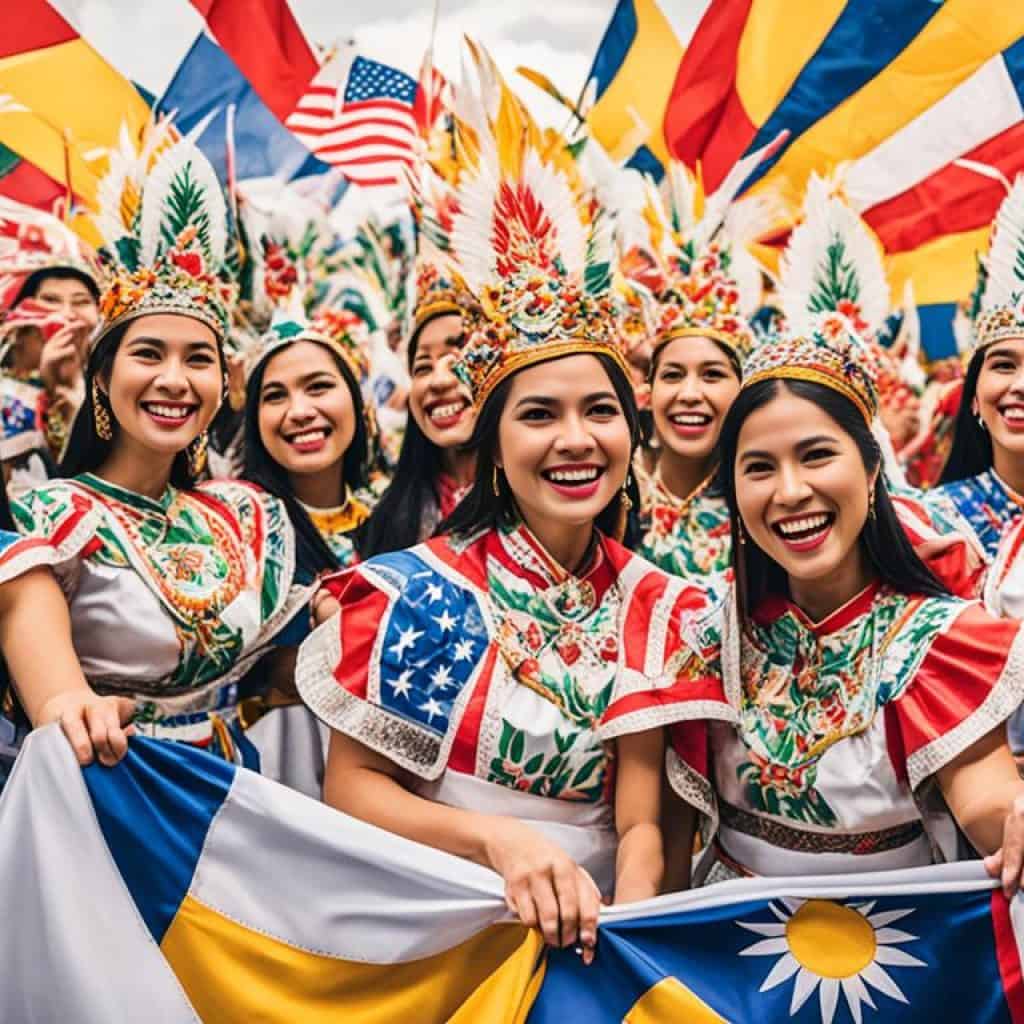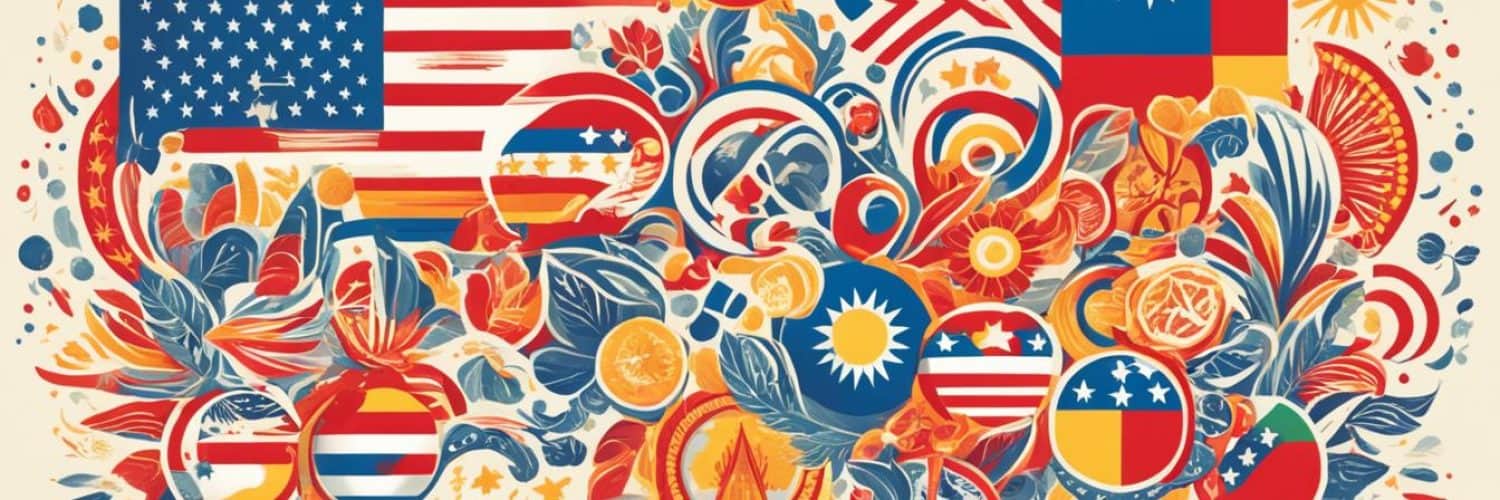Have you ever wondered about English spoken in the Philippines? What makes it different from standard American English? Let’s explore the unique aspects of Filipino English and its impact on the US.
Key Takeaways:
- Filipino English emerged as a result of the historical influence of the English language in the Philippines during the US colonial occupation.
- It coexists with the national language, Tagalog, and has gained prominence in various aspects of Filipino society.
- Filipino Americans, exposed to both Tagalog and English, often maintain fluency in English while using their native language in specific situations.
- Filipino English has been strongly influenced by American English, with distinct pronunciation and spelling patterns.
- Understanding Filipino English provides insight into the cultural significance and hybrid linguistic identity of Filipino Americans in the United States.
The Role of Dialects in the Philippines
Besides Tagalog, the Philippines’ national language, the country is home to over 100 dialects. These dialects are spread across different regions. According to the Philippine Census, Tagalog leads in prevalence, followed by languages like Cebuano and Ilokano. Among others are Hiligaynon, Waray-Waray, and Kapampangan.
Even though Filipino Americans are good at English, they prefer their native dialects when stressed.
Dialects are crucial in shaping the Philippines’ language and culture. They show the country’s diversity and help people communicate across regions. Each has its unique words, grammar, and pronunciation.
For Filipino Americans, staying connected to their roots through dialects is important. They might use English every day, but speaking in their dialects helps keep their culture alive. It gives them a unique identity.
Dialects come out naturally in tense situations. This shows how vital they are for expressing oneself and feeling connected to one’s culture.
Understanding the importance of dialects in the Philippines lets us appreciate its linguistic diversity. It shows us the rich heritage of the Filipino people.
Most Widely Spoken Dialects in the Philippines
| Dialect | Approximate Number of Speakers |
|---|---|
| Tagalog | Over 23 million |
| Cebuano | Over 21 million |
| Ilokano | Over 8 million |
| Hiligaynon | Over 8 million |
| Waray-Waray | Over 7 million |
| Kapampangan | Over 2 million |
| Chavacano | Over 2 million |
| Northern Bicol | Over 1 million |
| Pangasinan | Over 1 million |
| Southern Bicol | Over 1 million |
Language Use Among Filipino Americans
Language use among Filipino Americans changes with age and how much they’ve adapted to American culture. The US Census Bureau says about 9% of them speak only English at home. But most mix Filipino dialects and English in their daily talks.
Young Filipino Americans who grew up here are more fluent in English. They learned it through schools and media. So, they mostly speak English with friends and at work.
Older ones, who came to the US later, often stick to their Filipino languages. They might use it at home or during cultural events. Even if they know English well, they hold on to their roots by speaking their original language.
It’s essential for Filipino Americans to speak English for fitting in America. But keeping their dialects and speaking Filipino English helps keep their culture alive. This blend helps them feel connected as a community.
Maintaining Language and Culture
Knowing Filipino English and dialects helps them stay connected to their heritage. Language is a key to their traditions and values. It helps them balance their mixed identities.
Being bilingual opens up many opportunities in academics and careers. Speaking English and Filipino is a big plus in the global market. It is a skill many industries look for.
Speaking Filipino helps pass traditions to the next generations. Through language, they keep their cultural heritage alive in their families and communities.
“Language diversity, including the existence of Filipino English, enriches the cultural fabric of the United States. Embracing and valuing different language varieties allows for greater intercultural understanding and appreciation.”
The Importance of Learning Filipino English
There are many resources for learning Filipino English online. These lessons help people get to know the Filipino American community better. They improve language skills and cultural understanding.
Knowing Filipino English phrases shows respect and builds bonds. It recognizes and values the cultural diversity in the US.
| Language Use among Filipino Americans | Percentage |
|---|---|
| Only English at home | 9% |
| Combination of Filipino dialects and English | 91% |
Understanding Filipino English’s role promotes inclusion and diversity. It helps us connect better and appreciate the linguistic richness in the US.
The Influence of American English on Filipino English
Filipino English, called Philippine English, is shaped by American English. The Philippines and the United States share historical ties. These ties have led to Filipino English using many American pronunciations and spellings.
English is the second language in the Philippines, next to Tagalog. Filipino English has developed a unique version. It blends American English with Filipino language structure and vocabulary.
Filipino English includes unique terms and phrases. These additions show the creativity of the Filipino language. They add a special touch to the language.
“Filipino English is a fascinating linguistic blend, combining the fluidity and nuances of the English language with the expressive qualities of Filipino culture.”
For example, “sando” in Filipino English means a sleeveless undershirt. In American English, it’s called a “wife-beater.” The term “torch” in Filipino English means a flashlight, different from its American English use.
The mix of American English and Filipino language creates a need for Filipino English translations. Translators are key in capturing Filipino English expressions and translating them accurately.
The Influence of Media and Pop Culture
American English has shaped Filipino English through media and pop culture. U.S. movies, TV shows, music, and literature influence the Philippines. This exposure shapes Filipino English vocabulary.
This cultural exchange brings American English expressions to Filipino English. Phrases like “chill,” “cool,” or “awesome” are now common. They have entered the language through media.
The Role of Education
Education teaches Filipino English speakers American English. English is a subject in Philippine schools. Good English skills are valued. This focus strengthens American English’s impact on Filipino English.
Many Filipino students study in the United States. They use American English there. This experience helps them learn more American English expressions, adding to their language use.
The Ever-Evolving Language
Filipino English keeps evolving, mixing Filipino roots with American English. It’s a vibrant part of the Philippines’ linguistic scene and among Filipinos in the U.S.
Knowing how American English affects Filipino English shows the cultural and linguistic ties between the countries. It proves how flexible language is and the richness from cultural exchanges.
Unique Terminology in Filipino English
Filipino English is not just unique, but also rich in its own terms and expressions. It mixes American English with local phrases that carry different meanings. This mix makes the language special and shows the creative use of Filipino.
Salvage: In Filipino English, “salvage” takes on a much darker meaning. Unlike its American English meaning of “to save,” it means “killing” someone here. This shows how words can change dramatically between languages.
C.R.: The term “C.R.” is another unique part of Filipino English. It means “comfort room,” or what others might call a restroom. This term adds a local touch to the English spoken in the Philippines.
“Hostess”:
In Filipino English, “hostess” carries a negative meaning. It is used to refer to a prostitute, unlike in American English, where it means someone who entertains guests.
Ref: “Ref” is a common term in the Philippines for a refrigerator. Though not used in American English, it’s a staple in Filipino English for this kitchen appliance.
These examples show how Filipino English keeps evolving. For those who want to learn more about these unique terms, a Filipino English dictionary is a great tool. It helps learners understand the language better.

This image shows a Filipino English dictionary. It’s a useful guide for those interested in the language’s unique terms and expressions. It’s excellent for anyone looking to explore Filipino English and its rich vocabulary.
Cultural Significance of Filipino English Terms
In Filipino English, some words have deep cultural and historical meanings. They show the unique setting of the Philippines. These words are part of Filipino life and add to the language’s richness.
“Nose bleed” is a term used when English is hard to understand or speak. This phrase shows the struggle with complex English. It’s common among Filipinos and shows how English affects their culture.
“CR” means restroom in Filipino English. It comes from the Spanish “Cámara,” showing Spain’s past control over the Philippines. Choosing “CR” over “restroom” shows how Filipino English has its own style.
“Nose bleed” and “CR” show the culture in Filipino society. They remind us of the history and social ties in Filipino English. This makes it a unique and lively version of the language.”
Studying these Filipino English words helps us understand important language details. They show more than just meanings. They connect us to a common cultural identity.
Language Maintenance Among Filipino Immigrants in the US
Filipino immigrants in the United States value keeping their language alive. It helps them keep their cultural identity. While they learn English to fit into American society, they also speak Filipino English. They use it with their family and in their community.
This practice keeps their culture vibrant. It makes them feel proud and connected to their Filipino heritage. Speaking their native language, including Filipino English, preserves their unique culture. It passes it on to the next generations. They can keep their traditions and way of life in the United States alive.
Despite American culture’s influence, language strongly holds their community together. It keeps their identity strong.
“Language is not only a means of communication but also a reflection of one’s cultural identity. As Filipino immigrants in the US, we hold onto our language to honor our roots and share our heritage with younger generations.”
Keeping the language means more than just talking. Filipino English is kept alive in writing too. You’ll find it in Filipino American publications, websites, and on social media. This helps the language stay relevant. It also helps maintain cultural identity online.
Language upkeep isn’t just for the older folks. Young Filipino Americans are getting involved too. They join in through schools, community classes, and cultural groups. They see the value in Filipino English. It links them to their roots.
The Benefits of Language Maintenance
Language maintenance has many benefits for Filipino immigrants. It lets them share their culture with their kids and grandkids. They can talk to family members who don’t speak English well. This strengthens their family bonds.
It also brings the Filipino community closer. Sharing a language creates a strong sense of belonging. People can express themselves, share stories, and support each other. It makes the cultural bonds stronger. It brings pride to the Filipino immigrants.
Beyond just feeling connected, keeping the language has practical uses. Being bilingual gives Filipino immigrants an advantage. It helps in job markets like customer service or translation. Bilingual skills are very valuable.
For Filipino immigrants, language maintenance is vital. It keeps their culture alive and strengthens community ties. Filipino English connects generations. It ensures the continuation of a rich linguistic tradition.
The Social Significance of Language Varieties
Different language forms carry social meanings. Filipino English in the U.S. shows the culture and identity of Filipino immigrants. It shapes how they connect with others.
English connects Filipino immigrants to wider American society. It helps them in schools, workplaces, and social life. “English in Filipino” shows a mix of both cultures.
Filipino English highlights Filipino Americans’ dual heritage. By using English, they show their Filipino roots and American identity.
The Role of Language Choices
Language choices affect social interactions. Filipino English creates a community feeling among Filipino Americans. It connects them with people with similar backgrounds.
Using Filipino English shows identity and cultural pride. It unites Filipino Americans, creating a strong bond across distances.
Filipino English also lets Filipino Americans express themselves. It’s a way for them to embrace their culture in American society. It shows their resilience in navigating different cultures.
Promoting Cultural Understanding and Inclusivity
Understanding language’s social role helps with cultural understanding. Appreciating Filipino English improves communication and makes society more inclusive.
Embracing language diversity reduces linguistic barriers. It leads to better cultural exchange and respect among communities.
Valuing languages like Filipino English is crucial in building a diverse society. It highlights the role of linguistic variety in creating a vibrant and inclusive community.
The Impact of Language on Identity
Language has a big role in shaping who we are. For Filipino immigrants in the United States, speaking Filipino English keeps them linked to their culture. It helps them feel they belong. This language shows where they come from and aids in living as Filipino Americans.
Speaking Filipino English lets them talk easily with others from similar backgrounds. It also keeps them connected to their Philippine roots. This language is a bridge between their past in the Philippines and their life in America.
Preserving Cultural Identity
For these immigrants, keeping their language alive is crucial to preserving their culture. By speaking Filipino English, they can pass on their traditions and values. This way, the beauty of Filipino culture is celebrated and kept alive through generations.
Speaking Filipino English allows Filipino immigrants to express their true selves, bridging the gap between their roots and the cultural blend of their new home.
Connecting with Community
Language is key to building strong communities. Filipino Americans who speak Filipino English find people with similar histories. This creates a bond based on shared culture. It gives them a sense of belonging and support in their new country.
Learning Filipino English can be very helpful. It’s great for those wanting to learn or get better at the language. These lessons help people connect, share experiences, and understand more about Filipino American culture.

Language is more than just talking; it shapes who we are. For Filipino immigrants in the US, Filipino English is vital. It helps them keep their culture, connect with others, and manage their dual identities. By valuing the language diversity among Filipino Americans, we build a welcoming and vibrant society.
Academic and Professional Opportunities for Filipino Americans
Filipino Americans speak English very well, including Filipino English. This gives them great advantages in school and work. They can easily work in the U.S. because their schooling in the Philippines is similar to America’s.
Knowing two languages, like Filipino English, opens up many chances for them. Their excellent English and understanding of culture help them succeed in business, healthcare, tech, and schools.
“Having fluency in Filipino English gives me an edge in my career. I can connect and communicate effectively with clients from the Philippines as well as colleagues in the United States. It’s an asset that sets me apart.” – Maria Santos, Filipino-American Entrepreneur
Filipino Americans are great at connecting different cultures. This improves their job chances and helps bring people together. They play a key role in promoting teamwork between cultures.
Academic Opportunities
Filipino Americans are well-prepared for U.S. colleges because of their strong English. They excel in writing, talking in class, and sharing their ideas.
They can also get scholarships and grants in the U.S. This helps them achieve their education dreams and start great careers.
Professional Opportunities
Being fluent in English, including Filipino English, is a big plus in the U.S. job market. Jobs in customer service, healthcare, and business need people who can talk well with everyone.
Their language skills let them work well with others in the U.S. and the Philippines. This makes them flexible and successful in many job settings.
Industries and Professions Attracted to Filipino Americans
| Industry | Professions |
|---|---|
| Healthcare | Registered Nurses, Physicians, Medical Technologists |
| Business | Entrepreneurs, Business Analysts, Marketing Professionals |
| Technology | Software Engineers, IT Specialists, Data Analysts |
| Education | Professors, Teachers, Counselors |
| Customer Service | Call Center Representatives, Service Desk Support |
This table shows which jobs and areas like the skills and backgrounds of Filipino Americans.
In summary, speaking English and Filipino English well is a big plus for Filipino Americans. It helps them do well in many jobs, bring cultures together, and connect well with people in the U.S. and the Philippines. Their language skills help them find many opportunities and succeed in the U.S.
The Future of Filipino English
Filipino English is changing and growing. It evolves as more Filipinos move around the world and culture shifts. The mix of American English and native dialects shapes Filipino English’s future. As new generations of Filipino Americans use it, they enrich America’s cultural and linguistic scene.
The Influence of American English
The Philippines and the United States share a deep history that affects Filipino English. American English plays a big part in this variant. It changes how words are pronounced, the words used, and grammar rules. This creates a special version of English that blends Filipino and American cultures.
Preservation of Native Dialects
Despite American English’s impact, keeping native dialects alive is crucial. The Philippines has over 100 dialects, adding depth to Filipino English. Mixing English with these dialects gives Filipino Americans a special way to express themselves. It helps Filipino English keep growing.
Cultural and Linguistic Contributions
Future Filipino American generations will keep Filipino English alive. It’s key to holding onto cultural roots and building understanding between cultures. This language connects different worlds, sharing ideas and traditions. It adds to the United States’ cultural diversity.
Embracing Linguistic Diversity
“Language is the road map of a culture. It tells you where its people come from and where they are going.” – Rita Mae Brown
Seeing the value in different languages, like Filipino English, enables us to appreciate various cultures better. It leads to a society that values and celebrates the unique backgrounds of its people. By welcoming diverse languages, we create a richer, more inclusive community.
The Importance of Language Diversity
Language diversity enriches the US’s cultural fabric. It leads to a better understanding of cultures. It also opens up ways for intercultural exchange.
Filipino English is unique and adds to the nation’s languages. Embracing Filipino English is crucial for inclusivity and promoting diversity. It helps us connect better as a society.
“Language is the road map of a culture. It tells you where its people come from and where they are going.” – Rita Mae Brown
Filipino English shows how language can adapt in multicultural places. It evolves with historical and cultural influences.
Just like every culture has its language, Filipino English mixes Filipino and English. It bridges cultures, offering a special way of communication.
Benefits of Language Diversity:
- Promotes cultural exchange and understanding
- Fosters inclusivity and appreciation of different cultures
- Enhances intercultural communication
- Encourages multicultural perspectives
By celebrating linguistic diversity, we respect all languages, including Filipino English. This creates a welcoming environment for everyone.
Example of Language Diversity in the United States:
| Language | Number of Speakers | Region of Influence |
|---|---|---|
| English | 250 million | Nationwide |
| Spanish | 43 million | Southwest, Florida, Puerto Rico |
| Chinese (including Mandarin and Cantonese) | 2.9 million | West Coast, New York City |
| Tagalog (Filipino) | 1.7 million | California, Hawaii |
This table shows the US’s language diversity. Different languages impact various regions. Filipino English adds to this language mix.
Language diversity reflects our culture and helps society progress. It changes as the society does. Thus, valuing languages like Filipino English is key to a dynamic, inclusive society.
Conclusion
Filipino English is a mix of cultures and languages. It plays a big part in the culture and language of the United States. It comes from the deep history and social connections between the Philippines and the United States. Filipino English shows how language can be resilient and adapt in a society with many cultures. It’s important to understand and appreciate this to make our society more inclusive and diverse.
As Filipino English grows, it adds to the United States’ language variety. This mix keeps the Filipino language’s spirit while also being influenced by American English. By valuing different types of languages like Filipino English, we help intercultural understanding and appreciation grow.
Recognizing Filipino English helps us appreciate Filipino Americans’ experiences. It connects them to their roots and their dual cultural identities. Knowing Filipino English, English, and native dialects gives Filipino Americans more chances in school and work. It also helps them navigate different cultures.
In short, Filipino English shows the power and beauty of language in a society with many cultures. Celebrating this language mix helps build a diverse and understanding society. Filipino English, English, and native dialects create a unique language pattern. This enhances our nation’s culture.







Add comment